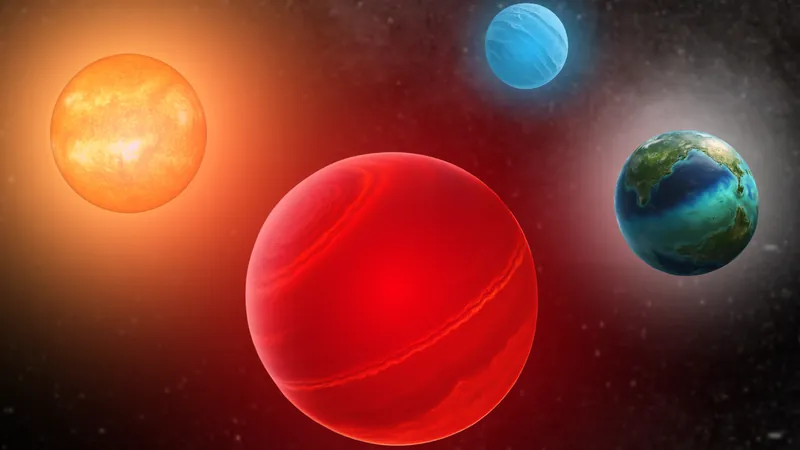
Groundbreaking Discovery: Multi-Planet System Challenges Hot Jupiter Misconceptions!
2025-01-15
Author: Jia
Introduction
In a startling revelation, scientists have discovered a remarkable multi-planet system that challenges the long-held belief that "hot Jupiter" exoplanets are solitary giants. This discovery could revolutionize our understanding of planetary formation and the evolution of solar systems.
Discovery Details
Located approximately 403 light-years away in the constellation of Lupus, the awe-inspiring system orbits around a K-type star named WASP-132. It features the enigmatic hot Jupiter, designated WASP-132b, alongside a newly identified inner super-Earth, WASP-132c, and a distant outer ice giant, WASP-132d.
Research Findings
The research, conducted by a collaborative team of experts from various institutions, including the University of Geneva and the National Center of Competence in Research (NCCR) Planets, has yielded fascinating insights. WASP-132b, the hot Jupiter, possesses a mass just shy of half that of Jupiter and completes an orbit around its star in a mere seven Earth days. In contrast, the super-Earth orbits in just over 24 hours and boasts approximately six times Earth's mass, while the outer icy giant, with a mass five times that of Jupiter, takes five years to circle its host star.
Historical Context
Since its inception in 2006 under the Wide-Angle Search for Planets (WASP) program, astronomers have meticulously studied this system. The voyage of discovery took an intriguing turn in 2021 when NASA's Transiting Exoplanet Survey Satellite (TESS) identified the super-Earth, showcasing the unique nature of the WASP-132 system. Despite being under investigation for nearly two decades, the system continues to reveal unexpected complexities.
Expert Insights
As revealed by University of Zurich astronomer Ravit Helled, “This finding underscores the remarkable diversity of planetary systems. It’s evident that we have much to learn about planet formation and the early stages of system evolution.”
Challenges to Existing Theories
But what makes this hot Jupiter so unusual? Traditionally, hot Jupiters—massive gas giants found close to their stars—are believed to form far out in their solar systems and then migrate inward. This method of inward migration usually leads to the destruction or ejection of any planets in the inner orbit, leaving hot Jupiters feeling "lonely." However, in the WASP-132 system, the super-Earth resides closer to the star than its hot Jupiter counterpart, raising questions about how a stable multi-planet system can exist under these conditions.
Implications for Planet Formation
Helled observes that the presence of the ice giant beyond the hot Jupiter indicates that planet formation can occur in proximity to hot Jupiters. Remarkably, the stable orbits of these planets suggest the possibility of a more stable migration pathway that differs from previously established models of planetary migration.
Future Research Directions
The researchers are now focused on deciphering what sets the WASP-132 system apart from others dominated by lonely hot Jupiters. “Our next steps involve both theoretical work to create models of how such systems might form and observational studies to determine how often we encounter similar multi-planet systems containing hot Jupiters,” Helled states.
Conclusion
This groundbreaking discovery underscores the complexities of planetary development and opens up exciting avenues for future research, as scientists strive to unravel the mysteries of celestial formation and the remarkable diversity of planetary systems in our universe. What secrets does WASP-132 hold? The quest for answers continues!


 Brasil (PT)
Brasil (PT)
 Canada (EN)
Canada (EN)
 Chile (ES)
Chile (ES)
 Česko (CS)
Česko (CS)
 대한민국 (KO)
대한민국 (KO)
 España (ES)
España (ES)
 France (FR)
France (FR)
 Hong Kong (EN)
Hong Kong (EN)
 Italia (IT)
Italia (IT)
 日本 (JA)
日本 (JA)
 Magyarország (HU)
Magyarország (HU)
 Norge (NO)
Norge (NO)
 Polska (PL)
Polska (PL)
 Schweiz (DE)
Schweiz (DE)
 Singapore (EN)
Singapore (EN)
 Sverige (SV)
Sverige (SV)
 Suomi (FI)
Suomi (FI)
 Türkiye (TR)
Türkiye (TR)
 الإمارات العربية المتحدة (AR)
الإمارات العربية المتحدة (AR)